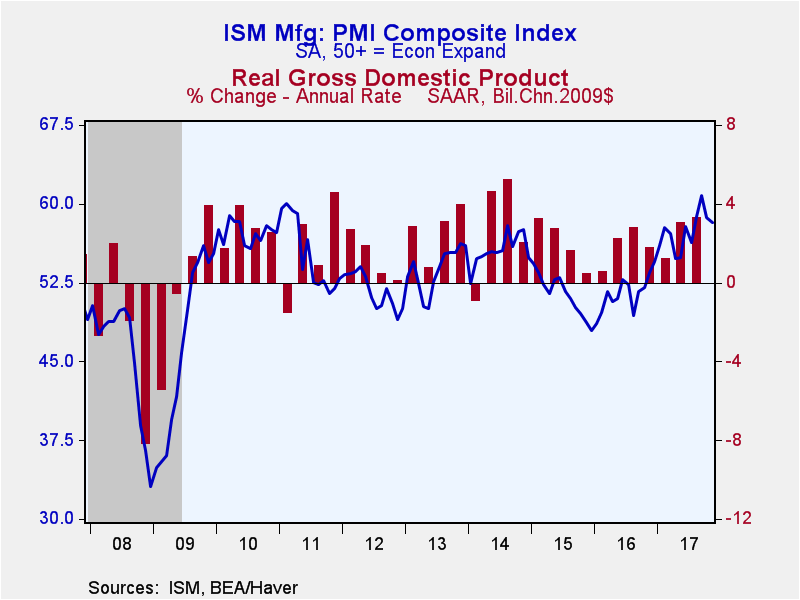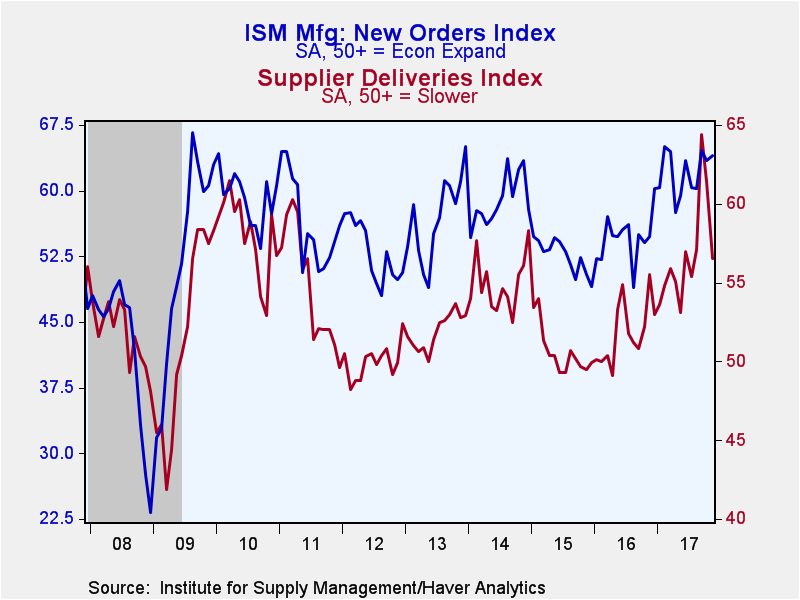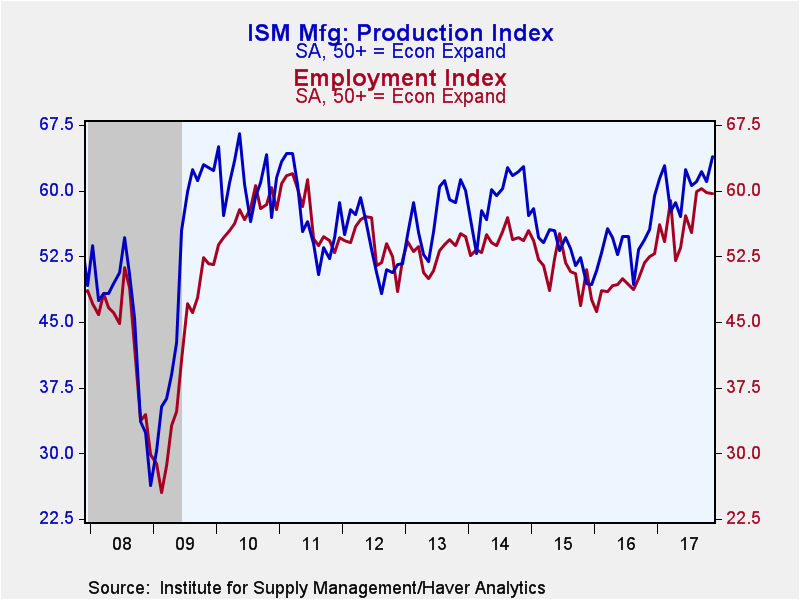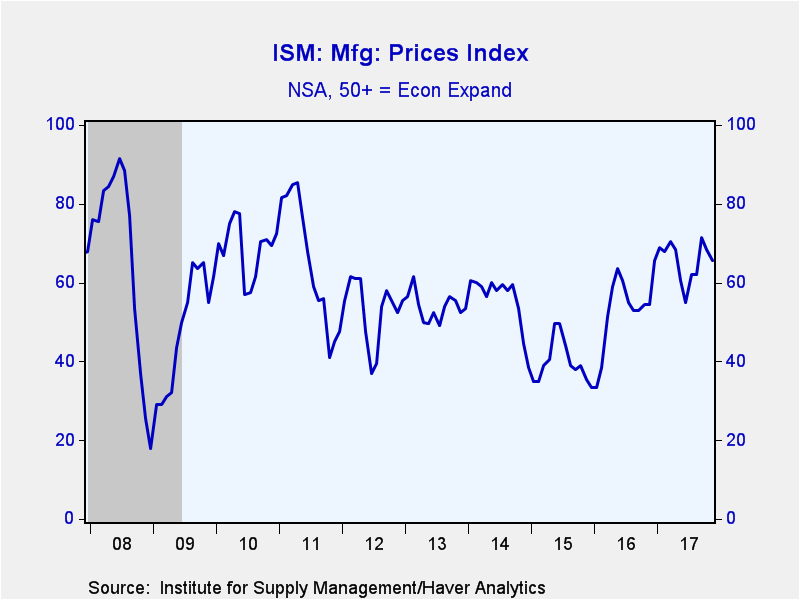 Global| Dec 01 2017
Global| Dec 01 2017ISM Factory Sector Index Eases; Pricing Power Wanes
by:Tom Moeller
|in:Economy in Brief
Summary
The ISM manufacturing sector composite index slipped to 58.2 during November from 58.7 in October. Despite recent declines, the index has indicated expansion in factory sector activity for fifteen straight months. A level of 58.4 had [...]
The ISM manufacturing sector composite index slipped to 58.2 during November from 58.7 in October. Despite recent declines, the index has indicated expansion in factory sector activity for fifteen straight months. A level of 58.4 had been expected in the Action Economics Forecast Survey. During the last ten years, there has been a 75% correlation between the level of the index and q/q growth in real GDP.
Last month's weakness was most pronounced in the supplier delivery series which indicated the quickest product delivery speeds since July. The inventories index also fell slightly m/m, but was sharply below its August high. Showing strength was the production series which increased to the highest level since March 2011. The new orders index also rose m/m and was up sharply from the 2016 low.
The employment figure eased minimally, but still signaled the fourteenth straight month of payroll expansion. During the last ten years, there has been an 88% correlation between the index and the m/m change in factory sector employment. Twenty-three percent (NSA) of respondents reported higher employment while seven percent indicated a decline.
The prices paid index continued to decline from its six-year high reached in September. Nevertheless, the index has significantly strengthened since a January 2016 low, when prices were declining. Thirty-seven percent (NSA) of respondents reported paying higher prices while six percent paid less.
The export order index slipped m/m and remained well below its June high. The index continued to indicate firm export growth, however, improved from the declines in 2015. The import order index rose slightly and remained below its July high. The order backlog series held steady.
The ISM figures are diffusion indexes where a reading above 50 indicates increase. The figures from the Institute for Supply Management can be found in Haver's USECON database. The expectations number can be found in Haver's AS1REPNA database.
Assessing the Risk of Yield Curve Inversion from St. Louis Fed President & CEO James Bullard can be found here.
| ISM Mfg (SA) | Nov | Oct | Sep | Nov'16 | 2016 | 2015 | 2014 |
|---|---|---|---|---|---|---|---|
| Composite Index | 58.2 | 58.7 | 60.8 | 53.5 | 51.5 | 51.4 | 55.6 |
| New Orders | 64.0 | 63.4 | 64.6 | 54.8 | 54.7 | 52.6 | 58.9 |
| Production | 63.9 | 61.0 | 62.2 | 55.6 | 54.0 | 53.5 | 59.2 |
| Employment | 59.7 | 59.8 | 60.3 | 52.5 | 49.7 | 51.0 | 54.4 |
| Supplier Deliveries | 56.5 | 61.4 | 64.4 | 55.5 | 51.9 | 50.7 | 55.0 |
| Inventories | 47.0 | 48.0 | 52.5 | 49.0 | 47.2 | 49.0 | 50.8 |
| Prices Paid Index (NSA) | 65.5 | 68.5 | 71.5 | 54.5 | 53.5 | 39.8 | 55.6 |
Tom Moeller
AuthorMore in Author Profile »Prior to joining Haver Analytics in 2000, Mr. Moeller worked as the Economist at Chancellor Capital Management from 1985 to 1999. There, he developed comprehensive economic forecasts and interpreted economic data for equity and fixed income portfolio managers. Also at Chancellor, Mr. Moeller worked as an equity analyst and was responsible for researching and rating companies in the economically sensitive automobile and housing industries for investment in Chancellor’s equity portfolio. Prior to joining Chancellor, Mr. Moeller was an Economist at Citibank from 1979 to 1984. He also analyzed pricing behavior in the metals industry for the Council on Wage and Price Stability in Washington, D.C. In 1999, Mr. Moeller received the award for most accurate forecast from the Forecasters' Club of New York. From 1990 to 1992 he was President of the New York Association for Business Economists. Mr. Moeller earned an M.B.A. in Finance from Fordham University, where he graduated in 1987. He holds a Bachelor of Arts in Economics from George Washington University.










